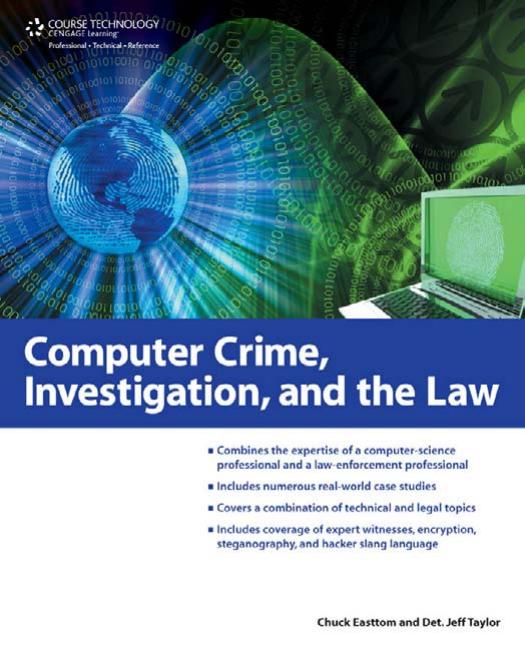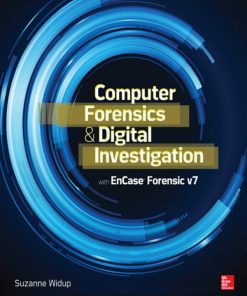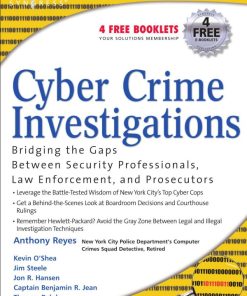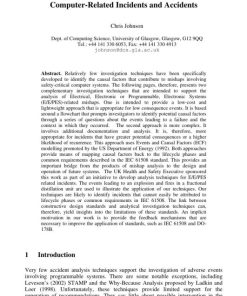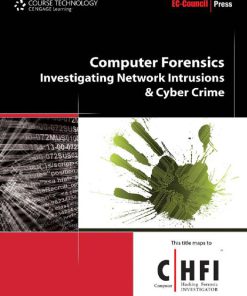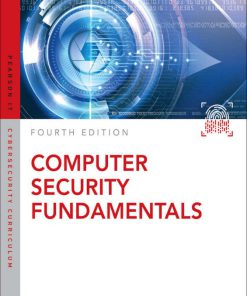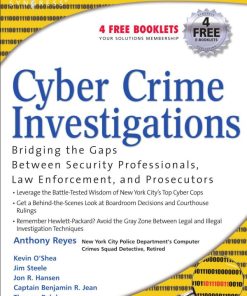Computer Crime Investigation and the Law 1st Edition by Chuck Easttom, Jeff Taylor ISBN 1435455320 9781435455320
$50.00 Original price was: $50.00.$25.00Current price is: $25.00.
Authors:Chuck Easttom, Jeff Taylor , Tags:1435455320 9781435455320 , Author sort:Chuck Easttom, Jeff Taylor , Languages:Languages:eng , Published:Published:Jul 2010
Computer Crime Investigation and the Law 1st Edition by Chuck Easttom, Jeff Taylor – Ebook PDF Instant Download/Delivery. 1435455320, 9781435455320
Full download Computer Crime Investigation and the Law 1st Edition after payment
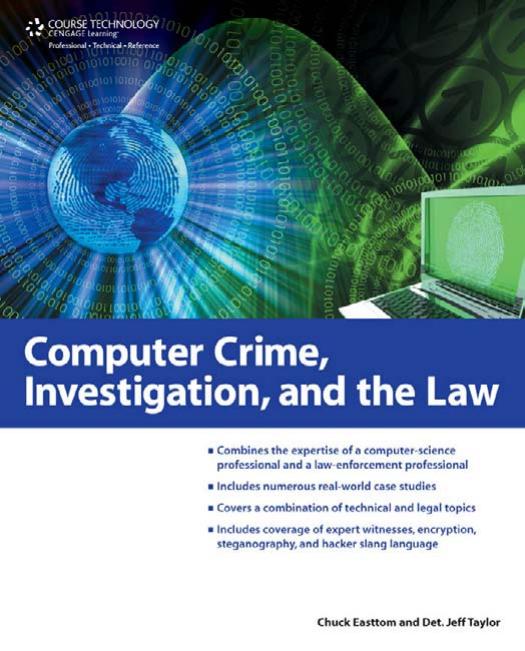
Product details:
ISBN 10: 1435455320
ISBN 13: 9781435455320
Author: Chuck Easttom, Jeff Taylor
One can hardly open a newspaper or read news online without seeing another story about a computer-related crime. We are awash in identity theft, online child predators, and even cyber espionage. It seems overwhelming. And people in many different professions find themselves involved with computer-crime investigations. Obviously, law-enforcement officers are involved, but so are network administrators, technical-support personnel, and attorneys. If any aspect of your work brings you into contact with computer crime, Computer Crime, Investigation, and the Law is for you. It begins with a broad introduction to the field of computer crime, discussing the history of computer crime, basic criminal techniques, and the relevant laws. Next, the book walks you through the essentials of computer forensics. Litigation is also explored, such as depositions, expert reports, trials, and even how one can select an appropriate expert witness. Lastly, the book introduces you to the specific techniques that hackers use and even shows you some of the tricks they use to infiltrate computer systems to help you defend against such attacks. This section of the book also includes a discussion of communication techniques used by computer criminals, with an overview of encryption, stenography, and hacker slang language. Computer Crime, Investigation, and the Law is your gateway into the world of investigating computer crimes.
Computer Crime Investigation and the Law 1st Table of contents:
Chapter 1: Introduction to Computer Crime and Cybercrime
- 1.1 Defining Computer Crime
- 1.2 The Evolution of Cybercrime
- 1.3 Types of Computer Crimes: Hacking, Fraud, Malware, and More
- 1.4 The Impact of Cybercrime on Society
- 1.5 The Role of Law Enforcement in Cybercrime Investigation
Chapter 2: Legal Framework for Cybercrime
- 2.1 International Laws and Cybercrime
- 2.2 National and Regional Cybercrime Laws
- 2.3 The Role of Data Protection and Privacy Laws
- 2.4 Key Legislation: The Computer Fraud and Abuse Act, GDPR, and Others
- 2.5 Challenges in Cybercrime Legislation
Chapter 3: Investigative Techniques in Cybercrime
- 3.1 Digital Forensics Overview
- 3.2 Data Recovery and Analysis Techniques
- 3.3 Investigating Malware and Viruses
- 3.4 Tracking Online Fraud and Identity Theft
- 3.5 Investigating Cyberstalking and Harassment
- 3.6 Techniques for Tracing and De-anonymizing Cybercriminals
Chapter 4: Evidence Collection and Preservation
- 4.1 Guidelines for Evidence Handling
- 4.2 Chain of Custody in Digital Evidence
- 4.3 Best Practices in Digital Evidence Preservation
- 4.4 Investigating Cloud Storage and Digital Transactions
- 4.5 Role of Cryptography in Digital Evidence
Chapter 5: Legal Considerations in Cybercrime Investigations
- 5.1 Jurisdiction and Legal Challenges in Cybercrime Cases
- 5.2 Search Warrants and Seizure of Digital Devices
- 5.3 The Role of Encryption in Investigations
- 5.4 Handling and Admissibility of Digital Evidence in Court
- 5.5 Ethical Considerations for Cybercrime Investigators
Chapter 6: Cybercrime Investigations: The Role of Law Enforcement
- 6.1 Law Enforcement Agencies Involved in Cybercrime
- 6.2 Collaboration Between National and International Law Enforcement
- 6.3 Cybercrime Units and Specialized Training
- 6.4 Case Study: Successful Cybercrime Investigations
- 6.5 The Role of Private Sector Partnerships in Investigations
Chapter 7: International Cooperation in Cybercrime Investigations
- 7.1 Cross-border Investigations and Challenges
- 7.2 International Treaties and Frameworks (e.g., Budapest Convention)
- 7.3 The Role of INTERPOL and EUROPOL in Cybercrime
- 7.4 Cooperation with Technology Companies and ISPs
- 7.5 Case Study: International Cybercrime Investigations
Chapter 8: Cybercrime and Intellectual Property Theft
- 8.1 Intellectual Property and Cybercrime
- 8.2 Investigating Software Piracy
- 8.3 Digital Copyright Infringement
- 8.4 Trade Secret Theft in the Digital Age
- 8.5 The Legal and Economic Implications of Intellectual Property Crimes
Chapter 9: Cyberterrorism and National Security
- 9.1 Understanding Cyberterrorism
- 9.2 Investigating State-Sponsored Cyberattacks
- 9.3 Cyber Warfare and Its Legal Ramifications
- 9.4 Protecting Critical Infrastructure from Cyberterrorism
- 9.5 The Role of National Security Agencies in Cybercrime Prevention
Chapter 10: Privacy, Surveillance, and Law Enforcement
- 10.1 Privacy Concerns in Cybercrime Investigations
- 10.2 The Legal Limits of Digital Surveillance
- 10.3 Internet Service Providers and Government Surveillance
- 10.4 The Ethics of Data Collection and Monitoring
- 10.5 Balancing Privacy and Security in the Digital Age
Chapter 11: Emerging Trends in Cybercrime and the Law
- 11.1 New Forms of Cybercrime: Ransomware, IoT Vulnerabilities, and AI Crimes
- 11.2 The Role of Cryptocurrency in Cybercrime
- 11.3 The Impact of Artificial Intelligence and Machine Learning on Cybercrime
- 11.4 The Future of Cybercrime Legislation and Law Enforcement
- 11.5 Preparing for Emerging Legal and Technological Challenges
Chapter 12: Case Studies in Cybercrime Investigation
- 12.1 Case Study: High-Profile Hacking Incidents
- 12.2 Case Study: Online Fraud and Financial Cybercrime
- 12.3 Case Study: Child Exploitation and Online Safety
- 12.4 Case Study: Government and Corporate Cyberattacks
- 12.5 Lessons Learned from Real-World Investigations
People also search for Computer Crime Investigation and the Law 1st:
computer crime, investigation, and the law
computer crime investigation and the law
why is computer crime difficult to investigate
what is crime investigation
computer crime law
You may also like…
eBook EPUB
eBook PDF
Computer Security Fundamentals 1st edition by William Easttom II ISBN 0135774772 978-0135774779

